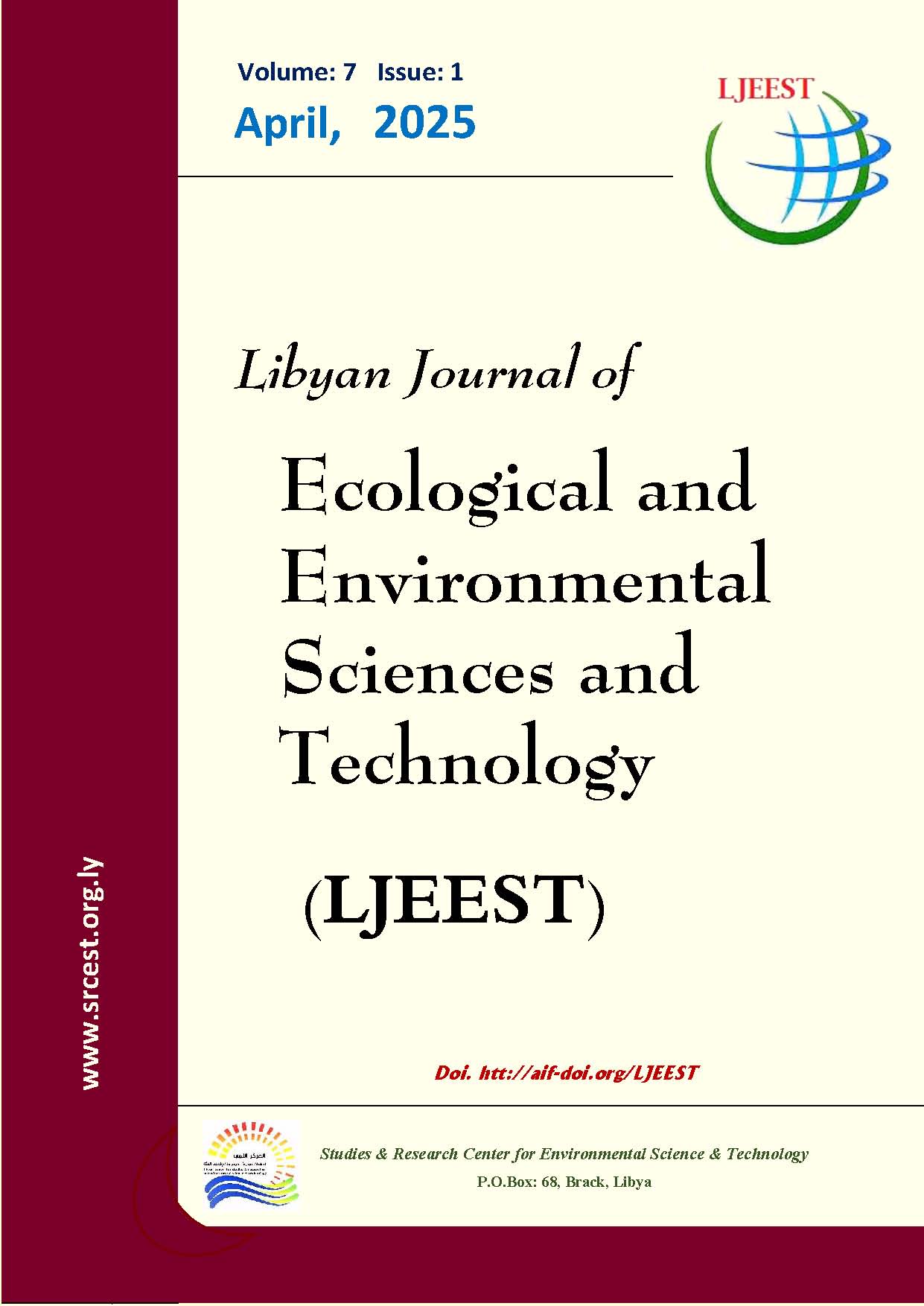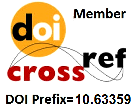Evaluating the Levels of Soluble Fraction In Artificial Saliva And Gastric Solution of Several Toxic Metals From Coloured Plastic Toys Linking to the Associated Health Risk Index
DOI:
https://doi.org/10.63359/4kyqd694Keywords:
Gastric Solution, Health Risk Index, Plastic Toys, SalivaAbstract
Several toxic metals are presented in children’s coloured plastic toys due to the addition of some of their compounds as stabilisers, painted agents and chemical and weather resistant layers. Unfortunately, fractions of hazardous metals may become bio-accessible to children’s saliva and gastric juices as result of hand-mouth behaviour ending up in the stomach. Thus, fourteen samples of most purchased coloured plastic toys were collected from markets in the western-mountain area in Libya. The aim was to evaluate the soluble fractions of Al, Cd, Cr, Mn, Ni, Pb, Sb, Sn and Zn in artificial saliva and 0.07 M HCl (simulating gastric solution) and based on the bio-accessible fractions of studied metals, calculate the associated health risk index (HI). The results demonstrated that the soluble fraction of Mn, Pb, Sb, Sn and Zn in saliva extractions was lower than the permissible levels of these metals set by EU countries. Findings indicated however that the levels of soluble fractions of Al in 100% of toys, Cd in 50% of samples, and Cr in 21% of samples migrated from the target toys to children saliva exceeding the allowable levels of these metals set by EU countries. Additionally, the concentrations of target metals in simulated gastric solution exceeded the limits of these metals set by EU countries for Cd in 57% of samples, Cr in 43% of toys and Pb in 50% of studied samples, but the levels of Al, Mn, Ni, Sb, Sn, and Zn in acid solution were below the limitations of these metals in the same solution recommended by EU countries. The HI values showed variation among metals and solutions reporting high risk in the case of Al in saliva, Mn and Ni in both solutions, Cd in most samples of both extractions and Pb in most samples of acid extraction. In conclusion, the use of these toys may cause harmful health effects to children that play with them for prolonged periods evidenced by the presence of a target metal in most acid and saliva extractions.
References
Al-Qutob, M., Asafra, A., Nashashibi, T., & Qutob, A. A. (2014). Determination of Different Trace Heavy Metals in Children’s Plastic Toys Imported to the West Bank/Palestine by ICP/MS-Environmental and Health Aspects. Journal of Environmental Protection, 05(12), 1104–1110. https://doi.org/10.4236/jep.2014.512108
Astolfi, M. L., Marconi, E., Lorini, L., Valentino, F., Silva, F., Ferreira, B. S., Canepari, S., & Majone, M. (2020). Elemental concentration and migratability in bioplastics derived from organic waste. Chemosphere, 259. https://doi.org/10.1016/j.chemosphere.2020.127472
Cui, X. Y., Li, S. W., Zhang, S. J., Fan, Y. Y., & Ma, L. Q. (2015). Toxic metals in children’s toys and jewellery: Coupling bio-accessibility with risk assessment. Environmental Pollution, 200, 77–84. https://doi.org/10.1016/j.envpol.2015.01.035
Echa. (2012). Cadmium And Cadmium Compounds In Plastics Upcoming Request From The Commission For Echa To Prepare An Annex Xv Dossier: Status And Preliminary Implications Preparatory Report.
Kamara, I., Adie, G. U., & Giwa, A. S. (2023). Total and bio-accessible toxic metals in low-cost children toys sold in major markets in Ibadan, South West Nigeria. Scientific African, 20. https://doi.org/10.1016/j.sciaf.2023.e01613
Karas, K., & Frankowski, M. (2018). Analysis of hazardous elements in children toys: Multi-elemental determination by chromatography and spectrometry methods. Molecules, 23(11). https://doi.org/10.3390/molecules23113017
Karcioglu, O., Rets, A., Salgado-Bustamante, M., & Capitão, C. (2022). Exposure to heavy metals and red blood cell parameters in children: A systematic review of observational studies.
Khan Tanoli, A., Ahmed, T., & Ahmed, M. (2021). Contamination by Hazardous Elements in Low-Priced Children’s Plastic Toys Bought on the local Markets of. https://doi.org/10.21203/rs.3.rs-1001076/v1
Klotz, K., Weistenhöfer, W., Neff, F., Hartwig, A., Van Thriel, C., & Drexler, H. (2017). The health effects of aluminum exposure. Deutsches Arzteblatt International, 114(39), 653–659. https://doi.org/10.3238/arztebl.2017.0653
Mračević, S. D., Ražić, S., Trišić, J., Mitrović, N., & Dukić-Ćosić, D. (2022). Toxic elements in children’s crayons and colored pencils: Bio-accessibility assessment. Journal of the Serbian Chemical Society, 87(6), 723–734. https://doi.org/10.2298/JSC20091078D
Oyeyiola, A. O., Akinyemi, M. I., Chiedu, I. E., Fatunsin, O. T., & Olayinka, K. O. (2017). Statistical analyses and risk assessment of potentially toxic metals (PTMS) in children’s toys. Journal of Taibah University for Science, 11(6), 842–849. https://doi.org/10.1016/j.jtusci.2017.02.005
Shahzad, L., Ali, M., Zubair, H., Sharif, F., Hayyat, M. U., & Ghafoor, G. Z. (2022a). Detection of heavy metals in children playing products and its associated health risk assessment in Lahore, Pakistan. International Journal of Environmental Analytical Chemistry. https://doi.org/10.1080/03067319.2022.2106433
Shahzad, L., Ali, M., Zubair, H., Sharif, F., Hayyat, M. U., & Ghafoor, G. Z. (2022b). Detection of heavy metals in children playing products and its associated health risk assessment in Lahore, Pakistan. International Journal of Environmental Analytical Chemistry. https://doi.org/10.1080/03067319.2022.2106433
Turner, A., & Filella, M. (2021). Hazardous metal additives in plastics and their environmental impacts. In Environment International (Vol. 156). Elsevier Ltd. https://doi.org/10.1016/j.envint.2021.106622
BURG, 2015. Aluminium-coated plastic - Metallisation of plastic components. Available at: https://burg-thermoforming.com/en/blog/aluminium-coated-plastic-metallisation-of-plastic-components. [Accessed by 31 July2024].
Fadaei, A., 2023. An investigation into the present levels of contamination in children’s toys and jewelry in different countries: a systematic review. Reviews on Environmental Health, 38(4), pp.601-611. https://doi.org/10.1515/reveh-2022-0064
Irhema. S. R. S., 2006. Estimating the amount of lead in ceramic utensils manufactured in Gharyan. Master thesis in environmental sciences. Libyan Academy. Libya.
Janssen, M.P.M., Spijker, J., Lijzen, J.P.A. and Wesselink, L.G., 2016. Plastics that contain hazardous substances: recycle or incinerate?.
Wright, J. (2003). Environmental Chemistry. 1st ed. Routledge. New fetter. London. EC4P. 4EE. pp; 208 – 211. https://doi.org/10.4324/9780203414101: accessed by 23/9/2024
Weidenhamer, J.D. and Clement, M.L., 2007a. Widespread lead contamination of imported low-cost jewelry in the US. Chemosphere, 67(5), pp.961-965. https://doi.org/10.1016/j.chemosphere.2006.10.07. accessed by 25/9/2024
Downloads
Published
Issue
Section
License
Copyright (c) 2025 Libyan Journal of Ecological & Environmental Sciences and Technology

This work is licensed under a Creative Commons Attribution-NonCommercial 4.0 International License.














